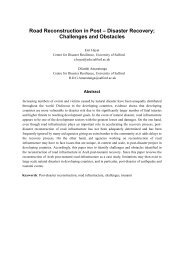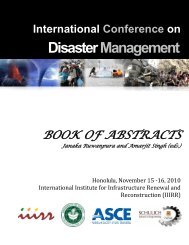Spatial Pattern of Socio-economic Landslide Vulnerability and its ...
Spatial Pattern of Socio-economic Landslide Vulnerability and its ...
Spatial Pattern of Socio-economic Landslide Vulnerability and its ...
Create successful ePaper yourself
Turn your PDF publications into a flip-book with our unique Google optimized e-Paper software.
4. RESULT AND DISCUSSION<br />
4.1. Central Tendency <strong>and</strong> <strong>Spatial</strong> <strong>Pattern</strong> <strong>of</strong> <strong>Socio</strong>-<strong>economic</strong> <strong>L<strong>and</strong>slide</strong> <strong>Vulnerability</strong><br />
Since the nature <strong>of</strong> people, social structure <strong>and</strong> culture <strong>of</strong> Kayangan Catchment were less influenced by<br />
the development <strong>of</strong> technology <strong>and</strong> modernization, the natural feature would more dominantly influence the<br />
way <strong>of</strong> life <strong>of</strong> the people in Kayangan Catchment. The area preference <strong>of</strong> building settlement was one<br />
example <strong>of</strong> social behavior mainly influenced by natural feature <strong>and</strong> condition. There were several options<br />
for a household to build a settlement, but there was limited option for low income household. Settlement<br />
type was <strong>of</strong>ten a reflection <strong>of</strong> welfare level. It was usually that low income household could not choose<br />
whether they would build their house in more gentle or steep topography. Therefore, low income household<br />
tend to build settlement based on their l<strong>and</strong> given from their parent or ancestor. It was usually located in<br />
steeper, more remote <strong>and</strong> low accessibility. For high income household, there were several options to build a<br />
settlement. They usually build a settlement in relatively gentle topography <strong>and</strong> have good accessibility. Good<br />
accessibility was the most common reason where they would build a settlement. Even, with the reason <strong>of</strong><br />
accessibility, they would build a settlement by excavating <strong>and</strong> cutting the slope into more gentle topography.<br />
Low income household living in low accessibility <strong>and</strong> hilly area had low <strong>economic</strong> ability <strong>of</strong> household<br />
to refinance the impact <strong>of</strong> natural disaster. They usually depend on the agricultural product <strong>and</strong> have low<br />
education level. Besides living in hilly area which was more prone to be l<strong>and</strong>sliding, they also had high<br />
socio-<strong>economic</strong> vulnerability level. There were interlinked between natural feature, social behavior,<br />
<strong>economic</strong> level <strong>and</strong> vulnerability level. It would affect the spatial pattern <strong>of</strong> settlement in Kayangan<br />
Catchment.<br />
Figure 2 Sampling Distribution, Mean Center, St<strong>and</strong>ard Distance (Left)<br />
<strong>and</strong> Directional Distribution (Right) <strong>of</strong> <strong>Socio</strong>-<strong>economic</strong> <strong>Vulnerability</strong><br />
<strong>Spatial</strong> mean center (SMC) provides an analysis where a phenomenon tends to be centered. Figure 2<br />
shows sampling location <strong>of</strong> socio-<strong>economic</strong> vulnerability level <strong>and</strong> their spatial mean centers. It is interesting<br />
to note that low vulnerability SMC tends to be located in the lower stream <strong>of</strong> Kayangan Catchment which<br />
has more gentle topography <strong>and</strong> nearby the center <strong>of</strong> trade, education <strong>and</strong> local government <strong>of</strong>fice location.<br />
In the other h<strong>and</strong>, the SMCs <strong>of</strong> medium <strong>and</strong> high level <strong>of</strong> vulnerability tend to be located in the upper part <strong>of</strong><br />
Kayangan Catchment which has steeper topography. It means that socio-<strong>economic</strong> vulnerability is spatially<br />
associated with topography <strong>and</strong> socio-<strong>economic</strong> functional unit.<br />
St<strong>and</strong>ard distance (SD) was employed to measure the distribution <strong>of</strong> socio-<strong>economic</strong> vulnerability<br />
deviate from their SMC. Figure 2 (left) shows the spatial SD circle <strong>of</strong> socio-<strong>economic</strong> vulnerability. The low<br />
vulnerability level was the highest deviation from the spatial mean <strong>and</strong> the high vulnerability level was the<br />
lowest one. However, high vulnerability <strong>and</strong> medium vulnerability had no significance difference. It implied<br />
that low vulnerability level locations were highly dispersed. High <strong>and</strong> medium vulnerability levels were not<br />
so much deviated from their mean centre. High <strong>and</strong> medium vulnerability levels were mainly located on the<br />
hilly area <strong>and</strong> the boundary <strong>of</strong> deviation was not exceeding the hilly area <strong>of</strong> Kayangan Catchment.<br />
6<br />
- 525 -
















